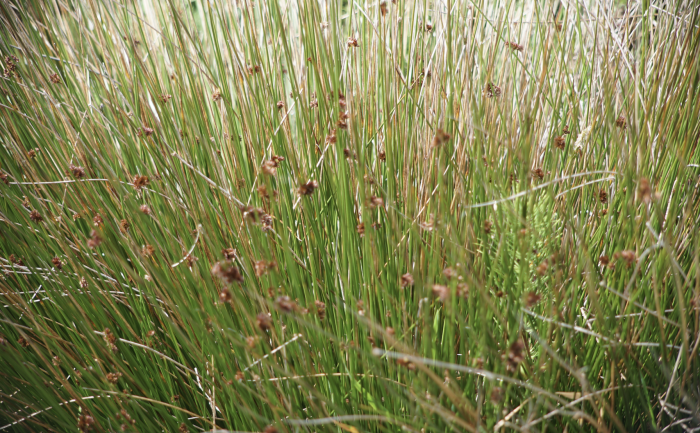Spreading Rush
(Juncus patens)
Spreading Rush (Juncus patens)
/
/

Karen and Mike
CC BY 4.0
Image By:
Karen and Mike
Recorded By:
Copyright:
CC BY 4.0
Copyright Notice:
Photo by: Karen and Mike | License Type: CC BY 4.0 | License URL: http://creativecommons.org/licenses/by/4.0/ | Rights Holder: Karen and Mike | Publisher: iNaturalist | Date Created: 2018-04-28T05:15Z |





































Estimated Native Range
Summary
Juncus patens, commonly known as Spreading Rush, is an evergreen grass-like perennial herb native to riparian zones, wetlands, and moist meadows along the west coast of the United States and northern Baja California. This plant typically forms dense, erect clumps of stems and can reach up to 3 feet (0.91 m) in height and 1–2 feet (0.30–0.61 m) in width. Its rhizomatous nature allows it to spread and can increase a colony’s width substantially, making it effective for soil stabilization. The inflorescence, which emerges laterally from the stem rather than the tip, bears numerous flowers with short, narrow, pointed tepals and six stamens, blooming in summer. The fruit is a spherical capsule, turning red or brown upon maturity, and is attractive to birds.
Spreading Rush is valued for its architectural form and adaptability, often used in rain gardens, bioswales, and as an accent in water-wise landscapes. It provides vertical interest in narrow garden beds and planters, and is suitable for container gardening. While it originates from moist habitats, Juncus patens is surprisingly drought-tolerant once established, making it a versatile choice for various garden settings. It thrives in full sun to part shade, requiring medium to high water levels, and prefers soils with slow to medium drainage. Although generally low-maintenance, it can become invasive if conditions allow unchecked spread.CC BY-SA 4.0
Spreading Rush is valued for its architectural form and adaptability, often used in rain gardens, bioswales, and as an accent in water-wise landscapes. It provides vertical interest in narrow garden beds and planters, and is suitable for container gardening. While it originates from moist habitats, Juncus patens is surprisingly drought-tolerant once established, making it a versatile choice for various garden settings. It thrives in full sun to part shade, requiring medium to high water levels, and prefers soils with slow to medium drainage. Although generally low-maintenance, it can become invasive if conditions allow unchecked spread.CC BY-SA 4.0
Plant Description
- Plant Type: Grass, Herb
- Height: 1.5-3 feet
- Width: 1.5-3 feet
- Growth Rate: Rapid
- Flower Color: N/A
- Flowering Season: Summer
- Leaf Retention: Evergreen
Growth Requirements
- Sun: Full Sun, Part Shade
- Water: Medium, High
- Drainage: Medium, Slow
Common Uses
Bird Garden, Border Plant, Deer Resistant, Drought Tolerant, Erosion Control, Low Maintenance, Potted Plant, Street Planting, Water Garden
Natural Habitat
Riparian zones, wetlands, and moist meadows along the west coast of the United States and northern Baja California
Other Names
Common Names: California Grey Rush, Gråtåg
Scientific Names: , Juncus patens,
GBIF Accepted Name: Juncus patens E.Mey.